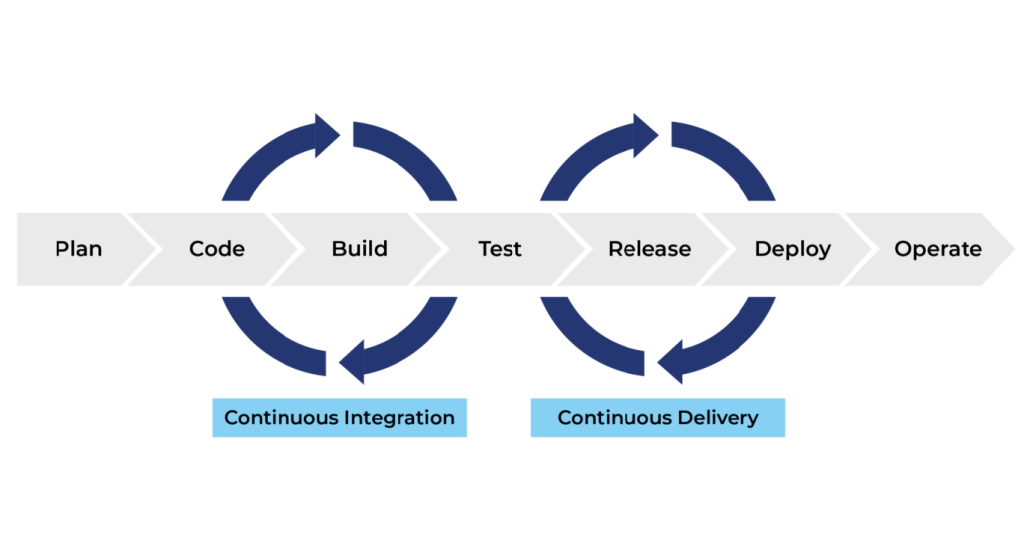
An effective (CI) continuous integration and (CD) continuous delivery pipeline is important for modern DevOps teams to cope with the rapidly growing technology landscape. Combined with elegant ideas, a fine CI/CD pipeline can streamline the software development life cycle resulting in higher-quality software with faster delivery.
What is a CI/CD pipeline?
The primary goal of a CI/CD pipeline is to automate the (SDLC) software development lifecycle. The pipeline will cover multiple aspects of a software development process, from writing the code and running tests to delivery and deployment. A CI/CD pipeline integrates automation and continuous monitoring into the development lifecycle.
This kind of pipeline, which contains all the stages of the software development life cycle and connects each stage, is collectively called a CI/CD pipeline. It will lessen manual tasks for the development team, decreasing the number of human errors while delivering fast outcomes. All of these contribute to the increased productivity of the delivery team.
Stages in a CI/CD pipeline
A CI/CD pipeline can be split into four main stages:
- Source
- Build
- Test
- Deployment
Each stage must be completed before continuing to the next step. In addition, all the stages are constantly monitored for errors or discrepancies, and feedback is provided to the delivery team.
In an agile context, each development, whether feature improvement or bug fix, falls into the CI/CD pipeline before deploying to production.
CI/CD pipelines are getting wider and updated
In the past, the CI/CD pipeline was just a place to integrate code. Developers would write their code in GitHub, pass it through the pipeline, and then deploy it. However, with the emergence of shift-left security and newer automation techniques, the pipeline has become a much more necessary piece of the software delivery lifecycle.
An end-to-end process
The change that has been made is security in the CI/CD pipeline. Now it needs an end-to-end approach with specific team members responsible for monitoring possible problem areas to ensure code compliance.
Complexity in pipeline grows
To make sure that the final product is performing the way it was intended to grow as the level of complexity within the pipeline does.
The need for automation
Another change that has been made to the CI/CD pipeline is the need for automation. Automation is the core of repeatability, predictability, and audibility. Moreover, for automation to work properly, the whole organization must be on the same page about those principles.
Benefits of CI/CD pipeline
The benefits of a CI/CD pipeline include the following:
- Efficient software development. Smaller steps allow for easier and more efficient testing. The limited scope of code in each new stage and the area to test it make finding and fixing bugs easier. Features are more readily estimated for usefulness and user acceptance, and less valuable features are easily adjusted or even abandoned before further development is wasted.
- Competitive software products. Traditional software development processes can take months or years, and standardized specifications and conditions aren’t well suited to changing user needs and expectations. CI/CD development readily adapts to new and changing requirements, enabling developers to implement changes in the next steps. Products developed with CI/CD can reach the market faster and more successfully.
- Better software maintenance. Bugs can take weeks or months to fix in traditional software development, but the constant flow of a CI/CD pipeline makes it easier to manage and fix bugs faster and with better assurance. The product is more stable and reliable over time.
- Better operations support. Frequent software releases keep operations staff in tune with the software’s requirements and monitoring needs. Administrators can better deploy software updates and handle rollbacks with fewer deployment errors and unnecessary troubleshooting. Similarly, IT automation technologies can help speed deployments while decreasing setup or configuration errors.
A properly configured pipeline will increase the productivity of the delivery team by lessening the manual workload and eradicating most manual errors. It will ultimately lead to a faster and more agile development life cycle that benefits end-users, developers, and the business. Get to grips with the modern DevOps pipeline to ensure that your operations always run smoothly and efficiently.




 July 5, 2022
July 5, 2022










